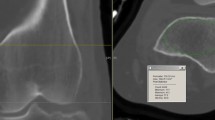Abstract
Introduction
Osteoporosis and decreased bone density are known to increase fracture incidence and severity. Although much is known regarding the effects of bone density on fracture risk and the treatment options for prevention of fragility fractures, whether bone quality alters clinical outcomes after fracture fixation is unknown. The purpose of this study was to determine whether bone quality correlates with clinical outcomes after fracture fixation.
Materials and methods
A prospective database of all operatively treated ankle fractures by a single surgeon from 2003 to 2013 was used to identify patients. All patients included in the study had preoperative computed tomography (CT) imaging of the injured ankle and postoperative CT imaging of the contralateral ankle. Hounsfield unit (HU) measurement values were determined by placing an elliptical region of interest confined to the cancellous metaphyseal region of the distal tibia and fibula. The primary and secondary clinical outcomes included Foot and Ankle Outcome Scores (FAOS) and ankle range of motion (ROM). Included patients had at least 12 months of clinical outcome data.
Results
Sixty-four patients met the inclusion criteria. Comparison of HU values from the injured and contralateral side demonstrated almost perfect agreement (ICC(2,1) = 0.938), suggesting that HU values can be accurately measured in the setting of a fracture. Increased HU values of the injured distal tibia and fibula significantly correlated with improved outcomes in four of five FAOS domains, including pain, activities of daily living, sports, and quality of life (beta = 0.285–0.344; P ≤ 0.05 for all). Range of motion outcomes did not significantly correlate with HU values.
Conclusions
Our results suggest that decreased bone quality, as measured using preoperative CT, significantly correlates with inferior short-term clinical outcomes. These results have significant implications for integrating bone quality into treatment algorithms for fracture patients.

Similar content being viewed by others
References
Unnanuntana A, Gladnick BP, Donnelly E, Lane JM (2010) The assessment of fracture risk. J Bone Jt Surg Am 92:743–753. https://doi.org/10.2106/JBJS.I.00919
Rosen CJ (2005) Clinical practice. Postmenopausal osteoporosis. N Engl J Med 353:595–603. https://doi.org/10.1056/NEJMcp043801
Ali AM, Saleh M, Eastell R et al (2006) Influence of bone quality on the strength of internal and external fixation of tibial plateau fractures. J Orthop Res 24:2080–2086. https://doi.org/10.1002/jor.20270
Johanson N, Litrenta J, Zampini JM et al (2011) Surgical treatment options in patients with impaired bone quality. Clin Orthop Relat Res 469:2237–2247. https://doi.org/10.1007/s11999-011-1838-6
Link TM (2012) Osteoporosis imaging: state of the art and advanced imaging. Radiology 263:3–17. https://doi.org/10.1148/radiol.2633201203
Eckstein F, Lochmüller E-M, Lill CA et al (2002) Bone strength at clinically relevant sites displays substantial heterogeneity and is best predicted from site-specific bone densitometry. J Bone Miner Res 17:162–171. https://doi.org/10.1359/jbmr.2002.17.1.162
Groll O, Lochmüller EM, Bachmeier M et al (1999) Precision and intersite correlation of bone densitometry at the radius, tibia and femur with peripheral quantitative CT. Skelet Radiol 28:696–702
Schreiber JJ, Anderson P, Hsu WK (2014) Use of computed tomography for assessing bone mineral density. Neurosurg Focus 37:E4. https://doi.org/10.3171/2014.5.FOCUS1483
Schreiber JJ, Gausden EB, Anderson PA et al (2015) Opportunistic osteoporosis screening—gleaning additional information from diagnostic wrist CT scans. J Bone Jt Surg Am 97:1095–1100. https://doi.org/10.2106/JBJS.N.01230
Schreiber JJ, Anderson P, Rosas HG et al (2011) Hounsfield units for assessing bone mineral density and strength: a tool for osteoporosis management. J Bone Jt Surg Am 93:1057–1063. https://doi.org/10.2106/JBJS.J.00160
Roos EM, Brandsson S, Karlsson J (2001) Validation of the foot and ankle outcome score for ankle ligament reconstruction. Foot Ankle Int 22:788–794
Landis JR, Koch GG (1977) The measurement of observer agreement for categorical data. Biometrics 33:159–174
Callréus M, McGuigan F, Akesson K (2013) Adverse effects of smoking on peak bone mass may be attenuated by higher body mass index in young female smokers. Calcif Tissue Int 93:517–525. https://doi.org/10.1007/s00223-013-9785-8
Lee JJ, Patel R, Biermann JS, Dougherty PJ (2013) The musculoskeletal effects of cigarette smoking. J Bone Jt Surg Am 95:850–859. https://doi.org/10.2106/JBJS.L.00375
Cummings SR, Melton LJ (2002) Epidemiology and outcomes of osteoporotic fractures. Lancet 359:1761–1767. https://doi.org/10.1016/S0140-6736(02)08657-9
Meredith DS, Schreiber JJ, Taher F et al (2013) Lower preoperative Hounsfield unit measurements are associated with adjacent segment fracture after spinal fusion. Spine (Phila Pa 1976) 38:415–418. https://doi.org/10.1097/BRS.0b013e31826ff084
Schreiber JJ, Hughes AP, Taher F, Girardi FP (2014) An association can be found between Hounsfield units and success of lumbar spine fusion. HSS J 10:25–29. https://doi.org/10.1007/s11420-013-9367-3
Tingart MJ, Lehtinen J, Zurakowski D et al (2006) Proximal humeral fractures: regional differences in bone mineral density of the humeral head affect the fixation strength of cancellous screws. J Shoulder Elbow Surg 15:620–624. https://doi.org/10.1016/j.jse.2005.09.007
Gausden E, Garner MR, Fabricant PD et al (2017) Do clinical outcomes correlate with bone density after open reduction and internal fixation of tibial plateau fractures. Arch Orthop Trauma Surg 137:1–6. https://doi.org/10.1007/s00402-017-2679-x
Funding
There is no funding source.
Author information
Authors and Affiliations
Corresponding author
Ethics declarations
Conflict of interest
The authors declare that they have no conflict of interest.
Ethical approval
This article does not contain any studies with human participants or animals performed by any of the authors.
Rights and permissions
About this article
Cite this article
Warner, S.J., Garner, M.R., Fabricant, P.D. et al. Bone density correlates with clinical outcomes after ankle fracture fixation. Arch Orthop Trauma Surg 138, 1653–1657 (2018). https://doi.org/10.1007/s00402-018-3017-7
Received:
Published:
Issue Date:
DOI: https://doi.org/10.1007/s00402-018-3017-7




